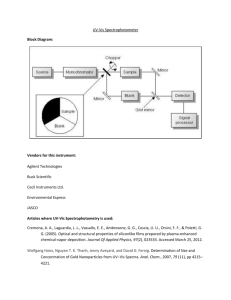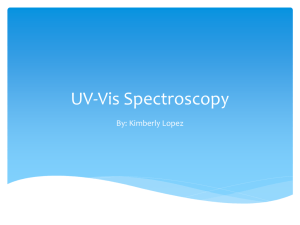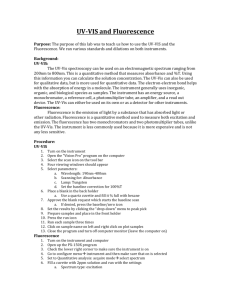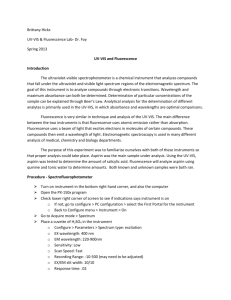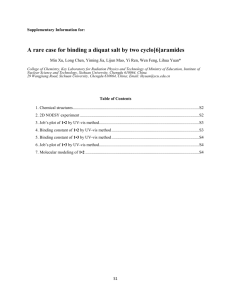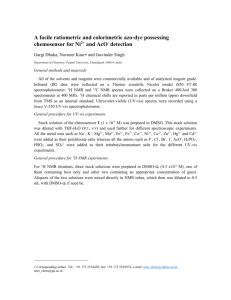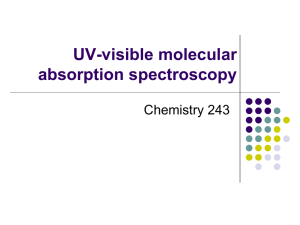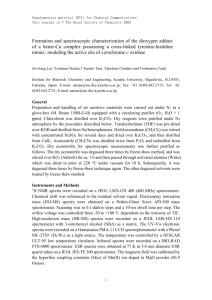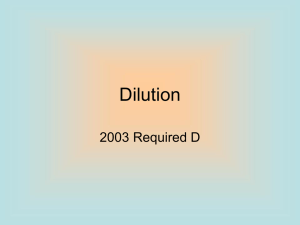UV-VIS SPECRTOSCOPY - MsShipp-Tink
advertisement
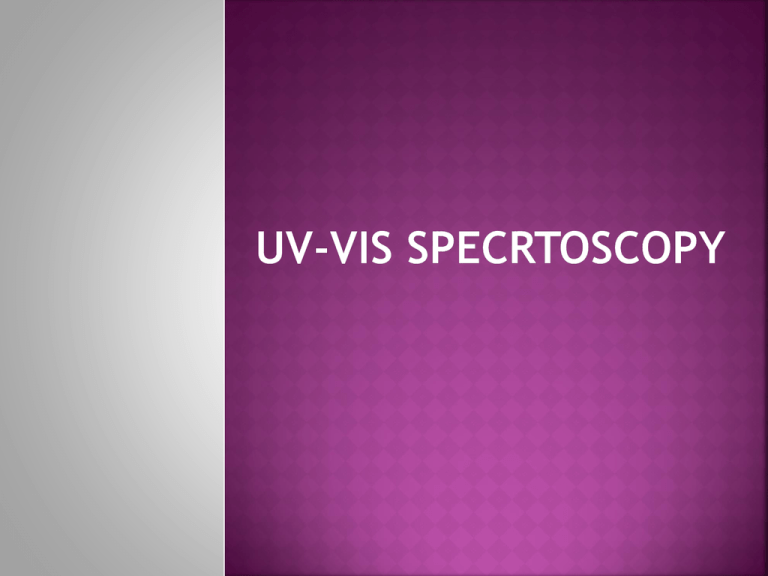
Ultraviolet-visible spectroscopy or ultraviolet-visible spectrophotometry refers to absorption spectroscopy or reflectance spectroscopy in the ultraviolet-visible spectral region. It analyses many substances on how they absorb wavelengths of light which can then be used to identify what compound they are make up of. When a substance absorbs light is appears a colour. The colour absorbed is the complementary colour of what it appears (it absorbs every other wavelength than the one it appears) . For example: chlorophyll- the pigment in green plants appears green since it absorbs violet and red light and not green which is reflected off the compound. It works by a light passing through a solution. The higher the concentration of the solution the more light is absorbed. Light of a certain wavelength and energy is reflected onto the sample, which absorbs an amount of energy from the light. The energy of the light transmitted from the sample is measured, which calculates the absorbance of the sample. After the light source is a monochromator which filters the light and selects a specific wavelength by using either a prism or a diffraction grating. After the monochromator is a series of lenses, slits, mirrors, and filters that concentrate, increase spectral purity and direct the light towards the sample containing the solutions to be tested. A detector calculates the amount of light being absorbed in the sample and the amount of light that goes through then helps analyse concentration of the sample. UV-VIS Spectrometers have either a single or double beam in the instrument. A single beam will only have a place for one sample to be run at a time, whereas, a double beam has two beams where an unknown and reference sample can be run at the same time. Usually in a UV Spectrometer there are two light sources: one gives out visible light and the other gives out UV light. Tungsten is usually used as the visible light and deuterium lamp is usually used as the UV light. A mirror opposite these light sources directs like from the source to the monochromator. The monochromator splits the light into wavelengths. This scans through the sample and the wavelengths- this is done by a grater which rotates. The wanted wavelength is then split into two partsone part goes through the sample and the other through the reference cell. Both wavelengths once pasted through each sample is reflected onto a detector, then this data is sent to the computer where it is graphed. The instrument has a lid that is shut once the sample and blank are placed in so that no light from the outside can interfere with the experiment. A computer controls the whole instrument. Diagram of a UV-VIS Spectrometer 1. 2. 3. 4. 5. 6. Sample is dissolved in a solvent Sample is placed in a test cell Pure blank= reference cell The cells are made form a special kind of glass which is able to transmit UV light A spectrum is obtained by measuring the absorbance against a range of frequencies This spectrum can then be compare to a known spectra for the substances in the sample. Simple diagram of how a UV-VIS Spectrometer works. The UV-Vis spectra arise because photons in this region of the electromagnetic spectrum have sufficient energy to make electrons from low energy levels to higher levels. This can occur in atoms, ions or molecules. Different substances have different energy levels, the energy and wavelength of light needed to “jump” the electrons vary. The spectrum is there to identify the substance. When the sample absorbs visible light a colour appears. The colour seen is the colour that is reflected off the sample, all the complementary colours are therefore absorbed. The method is used in a quantitative way to determine the concentrations of an absorbing species in a solution. The relationship between absorbance and concentration is described in the Beer Lambert Law: A= εcl Where A is the measured absorbance, c is concentration in mol-L, l is the length of the cell in cm and ε is the constant. If the same cell size is used, the absorbance can be used to measure the concentration of the analyte. For each species and wavelength, ε is the constant known (compound used as a reference). The Visible Spectrum from the UV Region to the IR Region. • • • • • Clinical analysis- measuring bodily fluid concentration such as blood and urine. Also the sugar and haemoglobin content in blood. In pathology labs in hospitals. Determining the amount of coloured dye in plastics Identifying a metal ions presence in a substance, even if the metal ion itself is colourless. Determining the amounts of nutrients, additives and contaminants in water and foods. In food and drink manufacturing companies. In quantitative analysis of DNA and proteins in molecular biology. • A light source shutter controls the level of light from a lamp that passes through the sample. The shutter is the only moving part of a UV-VIS spectrometer. The advantage of this system is the simple design of the instrument. • The sample analysis using UV-VIS is a very quick process compared to other methods of sample detection analysis. • The UV-VIS technique is non-destructive to the sample and has a high sensitivity for detecting organic compounds. • Less likely to suffer interference than other analytical techniques. • No single lamp emits all the light wavelengths necessary for analysis. Changing the lamp is a time-consuming process. • UV-VIS spectrometers need regular calibrations to maintain the accuracy and precision of the instrument. Choosing what type of material to use as the calibrator, requires the knowledge of the type of sample that is being analysed. • Stray light can be a problem for UV-VIS spectrometers. This can be caused by the person using it and trying to detect the sample using too much wavelength range or by poor instrument design. The data from the experiment is sent directly to the computer which controls the instrument. Here it is graphed on a calibration graph and depending on if it was a sample with a control sample, it will graph then against each other to show the differences in wavelengths and absorbance rates. It is interpreted by the colour on the spectrum which has a dip in the graph or no absorbance, it is that colour. It can also be assessed by seeing the colours that were absorbed by the sample and then matching then with their complementary colour which was reflected. By measuring the absorbance of light in the unknown solution, you can also find its concentration simply through the graph. Model of the colours in the UV-Vis Region. Finding the concentration of an unknown solution is made easy by simply graphing the absorbance rates on a calibration graph. Spectrometer calibration is a process where a scientific instrument known as a spectrometer is calibrated to confirm that it is working properly. This is important, as it ensures that the measurements obtained with the instrument are accurate. A UV-VIS Spectrometer is calibrated because the performance of Spectrometers includes testing the resolution, wavelength accuracy and stray light affect needs to be performing right to get precise results. The calibration of UV-VIS Spectrometers are performed with a combination of liquid filters and solid filters. Liquid and solid-state filters are calibrated by the filter manufacturers. Solid-state filters maintain their performance for many years when handled properly but the performance of liquid filters decreases much quicker due to slow irreversible chemical reactions, photonic-promoted chemical reactions, and other reasons. Wavelength accuracy is achieved through calibrating the peaks of several wavelengths in the UV, visible, and sometimes the IR spectra. A UV-VIS Spectrometer is capable of analysing: • Blood • Urine • Food • Drink • Dye in plastics • Metal ions • DNA • Proteins All of these substances above are capable of being analysed in everyday life, such as in hospitals and food manufacturing places. They need to be analysed for medical reasons, food safety reasons, colours of substances and also for compounds present in substances. It analyses these because it is able to detect substances which only absorb in the UV region, so it isn’t seen by the naked eye and could cause harm if not detected. • Very selective- less likely to suffer interference from similarly coloured compounds • Uses light of a specific frequency. • Similar to IR, NMR, GC and HPLC in terms of their analytes; organic compounds. • Like IR, NMR, GC, Gravimetric analysis, Volumetric analysis, HPLC and gravimetric analysis in the substances they sample; liquids and gases, food and water. • Advantages: Simple to operate (if you are a trained professional) and readily automated. • Like Gravimetric analysis and volumetric analysis, they are only suited to be run on larger concentrations. • As a detector for GC and HPLC can readily determine ppm levels of analytes. • TLC which needs to be coloured or visible under UV light. Refer to page 87 of your text books to worked example 7.4 which is an example of how a UV-VIS calibration graph is interpreted and how it can simply help you to find the concentration of the unknown sample if you already have its absorbance rate graphed. • • • • • • • UV-VIS is the oldest form of spectroscopy. There are two types of UV-VIS Spectrometers: Single-beam UV/VIS spectrophotometer the light only passes through the sample and double-beam UV/VIS spectrophotometer where the light passes through a “beam chopper” which directs the beam through the sample. Some substances such as the transition metals and some organic dyes are coloured and can be seen by the human eye which means they absorbs colours in both the ultra-violet and visible regions. Substances that are colourless to the human eye mean they only absorb in the ultraviolet region. The source of light produces white light which contains all wavelengths and all colours. Different wavelengths mean different colours. Less than 300nm is in the UV region and isn’t visible to human eyes. UV-VIS is usually run on solutions since light doesn’t pass through solids. Glass and plastic test tubes can not be used to hold the sample during the experiment since they absorb UV light. • http://www.ehow.com/list_6466475_advantages-disadvantages-uv_visspectrometer.html • http://answers.yahoo.com/question/index?qid=20061019181021AAeIE5X • http://en.wikipedia.org/wiki/Ultraviolet%E2%80%93visible_spectroscopy •http://www2.chemistry.msu.edu/faculty/reusch/VirtTxtJml/Spectrpy/UV -Vis/spectrum.htm •http://www.chemistrydaily.com/chemistry/UV/Vis_spectroscopy • Heinemann Chemistry 2 VCE Units 3 & 4 • Ms Shipp-Tink
